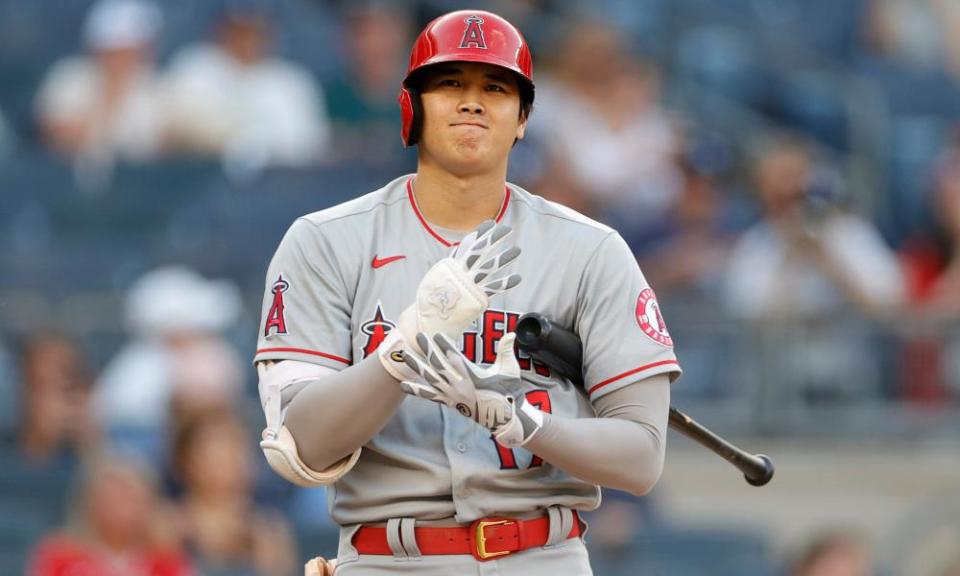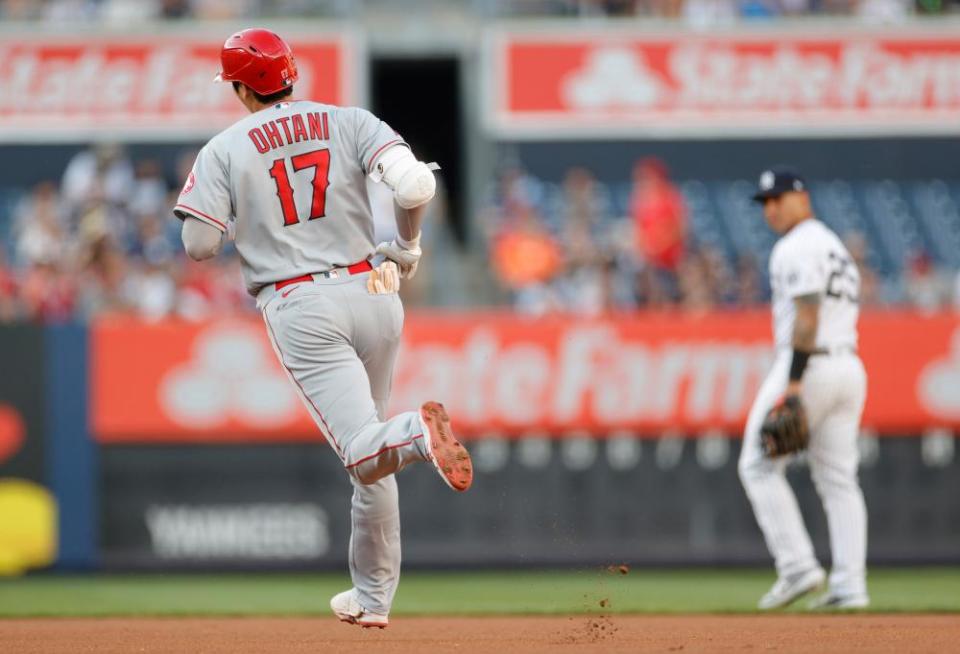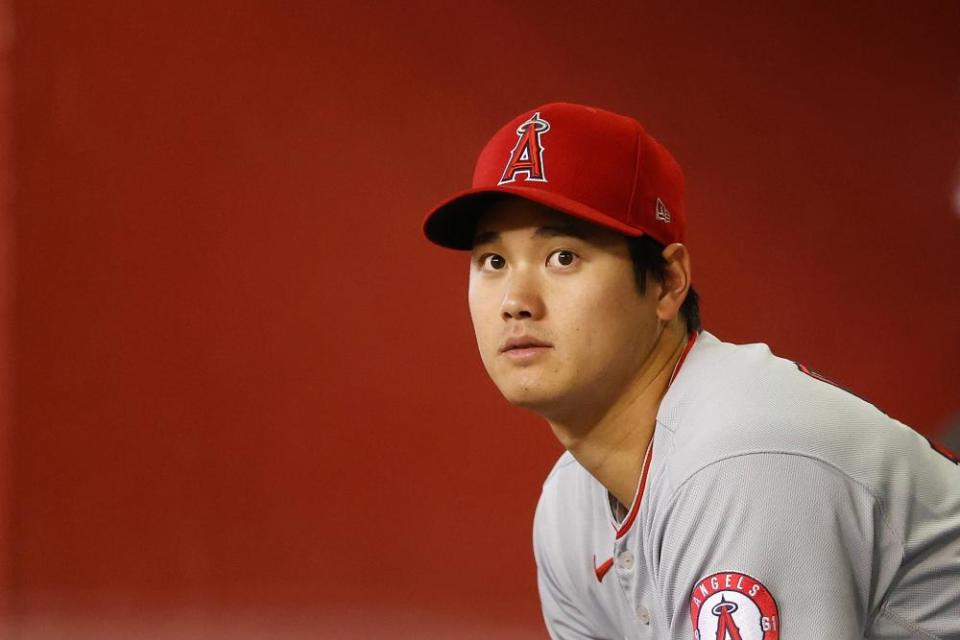Shohei Ohtani: the two-way Japanese marvel with once-in-a-century talent

For all the talk of its absence from victorious athletes and preening coaches, fear is one of sports’ dominant forces. It isn’t called that, of course; it’s called strategy, a plan, the better part of valor. But it is why NFL teams trot out their punting units on fourth down more often than they should, why aces on the precipice of World Series wins get pulled. Why the most singular athletic talent in the world – an apple-cheeked 27-year-old who hits left-handed home runs that jostle geometry and throws right-handed pitches that blur and vanish – wasn’t allowed to let that talent shine in full before this season. “He’s proven this year [that when] given the opportunity to do two things, that you should listen to him,” Los Angeles Angels manager Joe Maddon said in May of Shohei Ohtani, Major League Baseball’s first legitimate dual threat in a century. “I don’t see any real reason to interfere a whole lot.”
Related: Mets’ Pete Alonso bests Angels’ Shohei Ohtani to defend Home Run Derby title
As an MLB season beset by doldrums and scandal rounds its midway point, Ohtani has separated himself as likely the sport’s best player, and certainly its best show. The numbers astound no matter how often you look at them. (Many baseball fans do so daily.) As a hitter, Ohtani has clubbed an MLB-leading 33 home runs. As a pitcher, he’s racked up 87 strikeouts over 67 innings. Tuesday night, he will become the first player in big-league history to ply both trades at the All-Star game. But the most astonishing feat, in a year full of them, can’t be condensed into a highlight or read off a chart. By sheer force of talent, Ohtani has tilted a cynical game towards optimism; he’s made its fearful stewards think not in terms of what can go wrong, but of what might be possible.
Even as Ohtani first arrived stateside from the Hokkaido Nippon-Ham Fighters, in the spring of 2018, in a whirl of Babe Ruth comparisons and anticipatory jersey sales, the excitement around him was met by an encroaching front of caution. Mike Scioscia, then the Angels’ manager, set strict guidelines in the name of safeguarding a more than $20m investment. Ohtani would pitch once a week – most starters work once every five games – and take the days before and after his mound appearances off entirely. “I would like to play more,” Ohtani, who in Japan had hit whenever he wasn’t pitching, said after an opening fortnight characterized by bursts of spectacle and protracted periods of hand-sitting. “But if not, that’s what it is. I have to follow what they say.”

Near the end of a 2018 season that would earn him the Rookie of the Year award, Ohtani tore his ulnar collateral ligament, bringing on Tommy John surgery; depending on the vantage, this either validated the organization’s worries or marked an expected milestone in the evolution of a young flamethower. In 2019, Ohtani hit ably but didn’t pitch, and in 2020 a bout of forearm troubles and discomfort with the off-schedule pandemic season led to his worst year as a professional. He ended the year relegated to the bench; giving a gloomy interview in the offseason that followed, he called his showing “pathetic.”
Maddon had come to the Angels before the 2020 season with a reputation for working miracles; he’d taken the once-punchline Rays to the World Series in 2008 and broken the Chicago Cubs’ century-long championship drought in 2016. This spring, with Ohtani healthy and rearing to make up for lost time, the manager zigged where others had zagged. On the evening of Ohtani’s first pitching appearance of the season, in early April, Maddon slotted him in the second spot in the batting order – the first instance of true double-duty of Ohtani’s career, on either side of the Atlantic. Ohtani pitched four-and-a-third innings, allowing one run and striking out seven batters; in the second, he also stroked a shoulder-high fastball into the depths of the bleachers. “Just go pitch, go hit, just play baseball,” is how Maddon summed up his managerial directions, framing his own duty as one of encouragement, not protection. “That’s how a guy becomes a guy.”
The mandate has held all summer long, and the Guy Levels have soared; as Ohtani’s played more, he’s played better. During one four-start stretch in June, he K’ed 32 batters across 23 innings. Across a 17-game span starting the same month, he tallied 14 homers, a number of them launched at such improbable angles – lofted up against the roof of Tropicana Park in St Petersburg, or ziplined to rightfield in the Bronx – that they seemed borne less of a drive for athletic excellence than of an instinct for screwball comedy. In his last pitching outing before the All-Star break, on the heels of a rare off night against the Yankees, Ohtani held the American League-best Red Sox to two runs over seven innings, hitting an RBI double that registered at 107mph off his bat for good measure.
Among baseball fans, Ohtani has become an avatar of hope, the latest best chance at rescuing the league from stylistic uniformity and cultural irrelevance. (MLB’s executive office shares this reading; it included “Shotime” in the roster of players frozen in mega-posters along Sixth Avenue.) But even the savior of the game mantle undersells Ohtani’s meaning. He slots more comfortably onto the roster of cross-sport usurpers who have lately reached stardom’s top floor not by excelling within parameters but by exploding them: Stephen Curry, Lamar Jackson, possessors of talents so particular that they can turn something once considered peripheral (far-reaching threes, quarterback keepers) into foundations for MVP seasons. What these athletes share, besides hardware, are opening chapters organized around doubt. It can’t be done – it’s too risky or unsustainable, too far afield from what’s known to work – until they do it.

Ohtani’s Angels likely won’t match the playoff runs of Curry’s Warriors or Jackson’s Ravens, at least this season; part of the democratic appeal and frustration of baseball is that there’s only so much one player can do. (Even the post-All-Star return of Mike Trout won’t make up for the team’s dismal non-Ohtani pitching.) Still, the spectacle has its own stakes. Ohtani currently sits atop the MLB leaderboard in wins above replacement, and if he keeps up his current pace, an MVP is a near-inevitability. The more interesting question is whether he’s putting together the greatest single season ever; its unusual contours make such an argument delightfully difficult to settle. (Here Ohtani aficionados will spot something missing if I don’t note his speed, so: On top of everything else, he’s stolen 12 bases and legged out an AL-best four triples.)
But stats, awards, any conversations featuring the phrase “off all time” – at some point, these only elide the experience of staying up late to see the parabolas flying off of Ohtani’s bat and/or the 100mph heaters leaving his hand. It’s a joy tied fundamentally to ambition, not accomplishment. “I came here to do the two-way thing,” Ohtani said this spring, explaining his uptick. “That’s a big motivation for me to try to prove to everyone I’m capable of that.”
Whatever honorifics Ohtani’s season hoovers up by the end, it already stands as a testament to the power of hope, of straightforward striving, in an athletic culture too often overrun by doubt. “This is what he loves,” Maddon said of his superstar. “He loves baseball and he loves the challenge. I submit that by doing both you are seeing the best version of Shohei Ohtani, not by limiting him.” In the context of pro sports, these are radical words, positioning a player not as an asset to be managed but as a vector of potential. They flip the logic of risk on its head. Caution carries its own losses; aspiration can be the smarter play.

